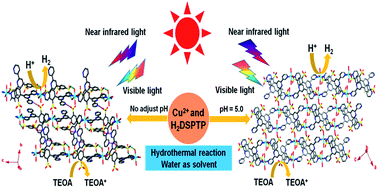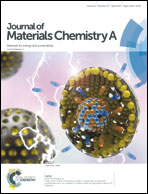Stable and improved visible-light photocatalytic hydrogen evolution using copper(ii)–organic frameworks: engineering the crystal structures†
Abstract
Relatively high photocatalytic H2 production activities can be exhibited by metal–organic framework (MOF) materials using a compulsory cocatalyst or photosensitizer. However, no study has focused on the effect of the crystal structures of MOF materials on the photocatalytic H2 evolution activity when using the same organic ligand and metal ion. Therefore, by connecting the 4′-(2,4-disulfophenyl)-3,2′:6′,3′′-terpyridine (H2DSPTP) organic ligand with CuSO4·5H2O, different MOF photocatalyst crystalline structures, (1) and (2), were obtained. These products were then respectively characterized and employed for photocatalytic H2 evolution. In the absence of any photosensitizer and cocatalyst, compounds 1 and 2 exhibited efficient visible-light-driven photocatalytic H2 production at maximum rates of 5.77 μmol h−1 and 6.99 μmol h−1. Interestingly, compounds 1 and 2 also exhibited photocatalytic H2 generation when irradiated with near-infrared light. Compound 2 showed outstanding long-term stability, as evidenced by eight-cycle tests over 24 h. The charge separation and transfer process of the compounds were verified using PL, time-resolved PL spectroscopy, and photocurrent measurements.



 Please wait while we load your content...
Please wait while we load your content...